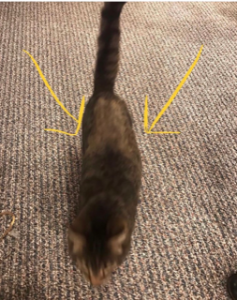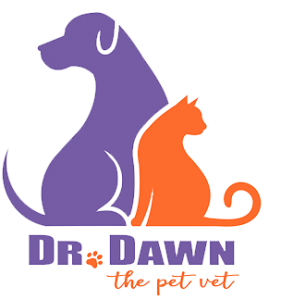As a mobile veterinarian, I see many cats. Many cats, as they age, develop hyperthyroidism. So, I thought it a worthy topic for discussion.
Hyperthyroidism is the most common endocrine disorder in middle to older aged cats. It occurs in about 10% of cats over 10 years of age. The syndrome is a result of excessive amounts of active circulating thyroid hormones. In 95-98% of hyperthyroid cats, this is due to a benign tumor of the thyroid gland. The other 2-5% are due to a thyroid carcinoma (malignancy). For most cats with this diagnosis, it is a favorable prognosis with treatment, particularly if caught early.
Clinical signs that you might see include :
-unexplained weight loss, particularly with a good to increased appetite
-increased urination, or more volume of urine in the litter box
-increased drinking or thirst
-increased vocalization
-defecation outside of the litter box
-restlessness, increased activity
-vomiting
-diarrhea
-change in eye appearance, or loss of vision

-rarely, lethargy and a lack of appetite
-poor hair coat, unkept fur
There are a multitude of other problems that can occur due to increased thyroid levels, and they are treated as they arise. Thus, monitoring blood thyroid levels and regular exams are key to catching the disease early and preventing secondary diseases, such as an increased appetite, weight loss, hypertension, cardiac disease, vomiting and diarrhea, loss of grooming, drinking excessively and possibly kidney disease. Cats not receiving regular veterinary care can become blind due to prolonged hypertension with undiagnosed hyperthyroidism.
Blood tests diagnose the disease. Other diagnostics are sometimes necessary. The heart and kidneys are often checked at the same time, which may involve chest or abdominal radiographs, ultrasound/echocardiogram and ECG’s of the heart, in addition to urine testing.
 Treatment is aimed at managing circulating thyroid levels and/or eliminating the abnormal thyroid tissue. Most cats are managed by oral medication, known as methimazole (tapazole). There is typically follow up a few weeks later to determine the target dose appropriate for each patient, to see if there are side effects from the medication, and to make sure that underlying kidney disease does not become more evident after managing the excessive thyroid hormone levels. Thereafter, most patients get blood levels checked every 6 months, depending on the patient.
Treatment is aimed at managing circulating thyroid levels and/or eliminating the abnormal thyroid tissue. Most cats are managed by oral medication, known as methimazole (tapazole). There is typically follow up a few weeks later to determine the target dose appropriate for each patient, to see if there are side effects from the medication, and to make sure that underlying kidney disease does not become more evident after managing the excessive thyroid hormone levels. Thereafter, most patients get blood levels checked every 6 months, depending on the patient.
The medication is available in tablet, liquid, or transdermal (absorbs through the skin) preparations. If a patient is still difficult to treat, or has experienced medical side effects, there are other treatment options. Abnormal tissue may be surgically removed, or eliminated with a radioactive iodide (I131) treatment. Special facilities offer this treatment. This one time treatment is typically curative, and does not require anesthesia.
Additionally, there is a new prescription diet that sometimes regulates the thyroid hormone levels, requiring no other treatment. It is a lifelong diet treatment.
Talk to your doctor about the treatment options, to decide what is right for you.
Dr. Dawn
Please share and subscribe here






